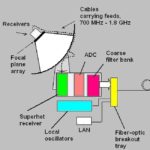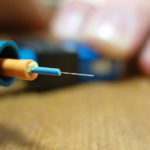NASA has announced it will pause work on the James Webb Space Telescope because of the ongoing COVID-19 pandemic. The launch is still currently on the books for 2021, but there are questions about whether that date will hold.

The James Webb Space Telescope, successor to the Hubble and Spitzer instruments, was originally scheduled to launch on an Ariadne 5 rocket from French Guiana in October, 2018. It has been subject to repeated cost overruns a rescheduling since its inception in 1996.
Once it is finally in orbit, the telescope will see farther back in time than its predecessors, imaging faint entities whose light has been in transit almost the entire 13.82 billion-year age of the universe.
The Webb Space Telescope will have far greater resolution that even the amazing Hubble Space Telescope. Having almost three times Hubble’s aperture, 6.5 m (21 ft), it will see from long-wavelength visible light through near-infrared to mid-infrared. A unique feature of the Webb instrument is its large sun shield, which will keep the mirror and associated instrumentation at a uniform 50°K. The effect of all this hardware will be to enable the instrument to process light from extremely faint objects and from the epoch of re-ionization. It is anticipated that exoplanets will be directly imaged, as opposed to being inferred by their effects on the host stars.
To do so, Webb’s mirrors collect light from the sky and direct it to instruments which filter the light, or spectroscopically disperse it, before finally focusing it onto the detectors. NASA says Webb has extended the state-of-the-art for infrared detectors by producing arrays that are lower noise, larger format, and longer lasting than their predecessors.

Webb uses two different types of detectors: mercury-cadmium-telluride (HgCdTe) “H2RG” detectors for the 0.6-5-μm near-infrared spectrum and arsenic-doped silicon (Si:As) detectors for the 5-28-μm mid-infrared range. (H2RG is the name of the Teledyne product line. Raytheon Vision Systems made the mid-infrared detectors.) Each Webb H2RG detector has about 4 million pixels. The mid-infrared detectors have about 1 million pixels each.
By varying the ratio of mercury-to-cadmium in the HgCdTe detectors, it is possible to tune the material to sense light of longer or shorter wavelengths. Webb takes advantage of this by using two compositions of HgCdTe: one with proportionally less mercury for 0.6 – 2.5 μm, and another with more for 0.6 – 5 μm. This has a number of advantages, including the possibility of tailoring each detector for peak performance over the specific wavelengths for which it will be used.
The telescope may read the pixels in its detectors more than once before resetting them. This provides several benefits. For example, it is possible to average multiple non-destructive reads to reduce the noise. Another advantage is that using multiple samples of the same pixel makes it possible to see the “jumps” in signal level that are the tell-tale sign that a cosmic ray has disturbed the pixel. Then ground-based processing can apply a correction to recover much of the scientific value of the affected pixel.





Leave a Reply
You must be logged in to post a comment.